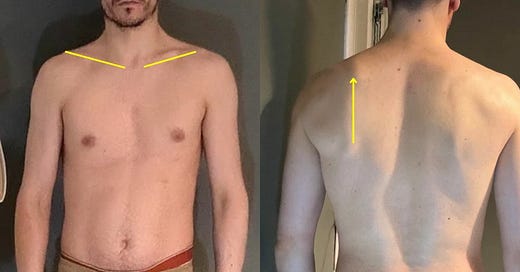How To Fix Uneven Shoulders
The shoulder girdle may rise or drop unevenly along the rib cage. This blog shares targeted exercises to help correct uneven shoulders.
Ever looked in the mirror and noticed one shoulder sitting higher than the other? It is more common than you think, and it is not just about appearance.
Uneven shoulders can throw off your balance, affect breathing, and create long-term tension patterns you may not even notice until pain sets in.
This blog offers a complete strategy to reverse the problem from the root. You will learn:
How to test if you have a high or low shoulder
What causes lopsided shoulders and postural asymmetry
How to fix unbalanced shoulders through specific drills
Targeted scapular elevation corrections
The truth about what really creates long-lasting shoulder balance
If you are tired of seeing one side sag or spike in photos, or if your shirts always fall off one shoulder, this is your starting point.
If you are wondering how to fix uneven shoulders, the first step is understanding what caused them. This kind of imbalance usually forms slowly over time due to habits that load one side of the body more than the other.
Fixing uneven shoulders is not about chasing symmetry it is about restoring functional alignment that lets your body move and feel the way it was meant to.
Do you:
Carry your bag over the same shoulder every day?
Sleep on the same side every night?
Always reach or twist in one direction at work or while using a computer?
Play a one-sided sport or instrument?
These repetitive patterns can shift your shoulder girdle into misalignment. Sometimes the issue is visible as scapular elevation, where one shoulder blade rides higher on the ribcage than it should. Other times, the shoulder may be depressed, dropping lower than normal due to weak support.
Over time, your nervous system accepts this new position as your “normal.” And once that happens, even your brain begins reinforcing the imbalance. That is why simply stretching or strengthening is not enough to fully correct one shoulder higher than the other.
How to Know If One Shoulder Is Higher Than the Other
Step 1: Check Your Collarbones
Stand tall in front of a mirror. Keep your arms relaxed.
Find your collarbones with your fingers and trace the line across.
Now look closely. Is one side sitting higher than the other?
Even a slight difference can point to a deeper imbalance your body has learned to live with. And often, that compensation shows up long before pain does.
Step 2: Uneven Upper Trapezius: Quick Self-Test
Here’s how to check if one side of your upper trapezius is sitting higher than the other:
Stand naturally in front of a mirror. Keep your shoulders relaxed.
Feel along the top of each shoulder to find the ridge of the upper trapezius muscle.
Look closely. Is one side higher, bulkier, or more raised?
Step 3: Uneven Shoulder Blades: Visual Check
Have someone take a clear photo of your back while you stand relaxed with arms at your sides.
Look at the shape and position of your shoulder blades (scapulae).
Notice if one is sitting higher, lower, or sticking out more than the other.
This difference can signal muscle imbalances or compensations that affect how your spine and shoulders move together.
Step 4: How To Test For A Forward Shoulder
Have someone take a photo of you from above, looking down at your shoulders while you stand relaxed.
Now look closely: is one shoulder sitting more forward than the other?
If the difference is significant, you may even be able to spot it by simply glancing down at your own shoulders. This forward shift often goes unnoticed until it starts affecting movement and posture. Pay attention to subtle angles and rotation it can reveal a deeper imbalance.
Step 5: How do your clothes fit?
Does one sleeve always slide down? Does your bra strap keep slipping off the same shoulder? That is not random, it is a sign that one shoulder is lower than the other. Your wardrobe is showing you what your body has quietly adapted to.
The step-by-step reset you’re about to follow can replace months of
failed stretching and hours of rehab with just five minutes a day. Download the
full implementation guide and printable routine to start rewiring your system
while everyone else is still foam rolling.How to Fix Uneven Shoulders (By Fixing the Signals Behind Them)
Step 1: Break the Habit Loop That Broke Your Posture










